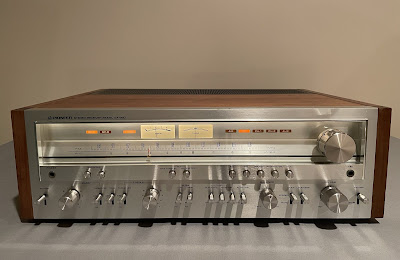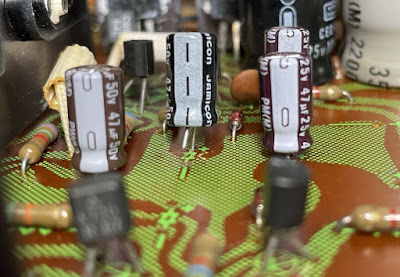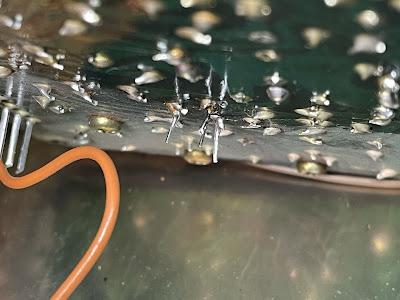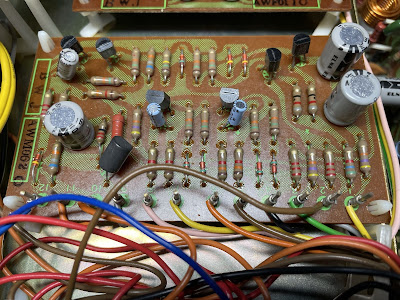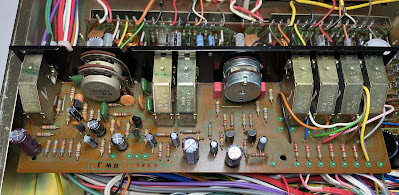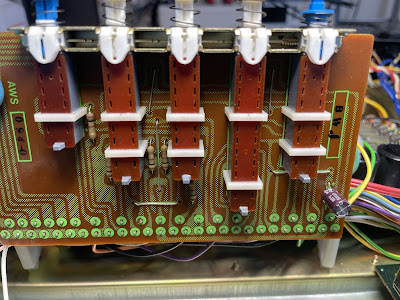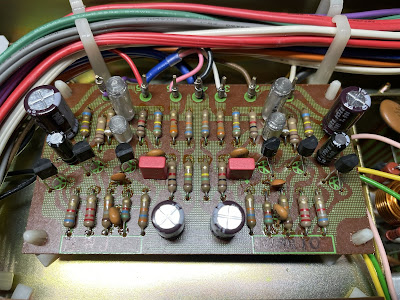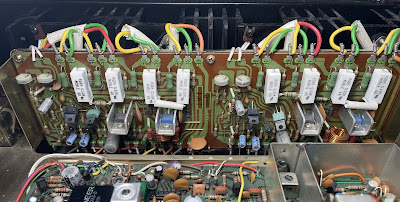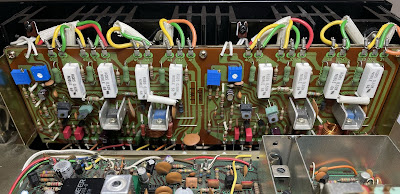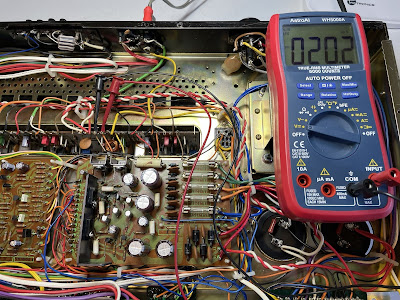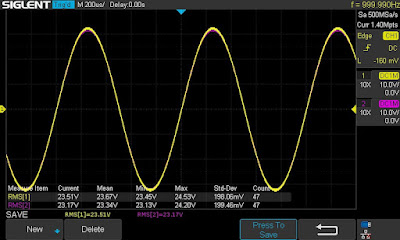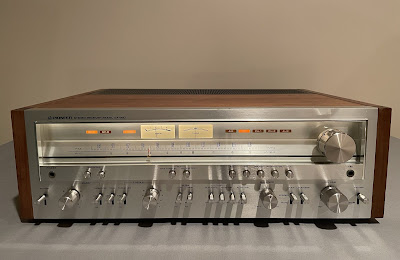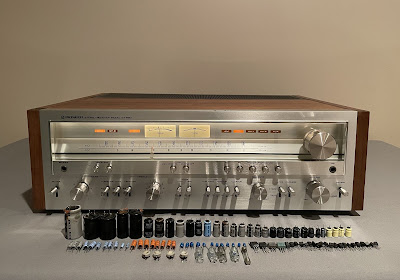Unit: AM/FM Stereo Receiver
Manufacturer: Pioneer
Model: SX-850
SN: WJ2901167M
A nice Pioneer SX-850 stereo receiver came on the bench for full restoration. The SX-850 is a high-end offering from Pioneer's most famous product line, the SX-X50 series. It was initially introduced in 1976 and made through 1978. It delivers a continuous power output of 65 watts per channel into an 8 ohms load from 20 to 20 kHz with no more than 0.1% total harmonic distortion. The SX-850 has a super-quiet phono equalizer in a 3-stage direct-coupled design to achieve a wide dynamic range and +/- 0.2dB RIAA equalization accuracy. The unit is heavy and weighs about 42 pounds without a package. As Pioneer states in its 1976's brochure "It's the Pioneer SX-850 - the one you can trust to keep faith with your musical needs".
According to the Pioneer database, this particular unit was manufactured in October 1976.
The restoration of the smaller brothers of SX-850 can be found on my blog here:
Power Supply (AWR-101)
The power supply board in this unit has been serviced before by somebody. And I wouldn't say that this work was done with high quality.
(a) The electrolytic capacitor C18 was replaced with a Jamicon e-cap and C21 with an ITT e-cap. Both brands are definitely not top-notch manufacturers. Moreover, the negative lead of e-cap C18 was not soldered to the PCB at all!
(b) Two no-name transistors were installed in positions Q8 and Q9.
(c) The original transistor installed in position Q5 was replaced with another 2SC1318 but the technician didn't cut off the leads after the soldering!
(d) Finally, a 2A fuse was installed in position FU6 instead of a 1.5A fuse.
The negative lead of e-cap C18 is not soldered at all!
A correct transistor was installed in position Q5 but the leads were not cut off - sloppy work!
The power supply board (AWR-101) has twelve aluminum electrolytic capacitors C10 thru C16, C18 thru C21, and C23. All of them were replaced with low impedance and high-reliability Nichicon UPW/UPM caps. The max operating voltage was increased one step up on several e-caps.
Note that the electrolytic capacitor C14 installed on this board (AWR-101-C) has a rated capacitance of 47uF/25V instead of 220uF/10V as on the schematic. I checked it against another SX-850 sitting on my bench and waiting for the restoration, and it also has the same rated capacitance in that position, i.e. 47uF/25V. So, it looks like this modification was not well documented by Pioneer which is actually pretty typical.
The original e-caps removed from this board were tested with an Atlas ESR70 capacitance meter and the results are below. Three out of twelve original e-caps are outside the factory capacitance tolerance +/- 20%. And the other three e-caps failed the test (open circuit/low capacitance)! These results are very similar to what I observed on the Pioneer SX-1010 power supply board (AWR-054-A). Both boards work under extreme operating conditions and become pretty well toasted after 45+ years of operation.
Test results on original capacitors removed from power supply board:
C10: rated capacitance – 470uF, measured – 368uF, ESR – 0.01Ω, deviation: -22%
C11: rated capacitance – 470uF, measured – 355uF, ESR – 0.01Ω, deviation: -24%
C12: rated capacitance – 2200uF, measured – 1986uF, ESR – 0.01Ω, deviation: -10%
C13: rated capacitance – 1000uF, measured – 1102uF, ESR – 0.02Ω, deviation: +10%
C14: rated capacitance – 47uF, measured – 55uF, ESR – 1.93Ω, deviation: +17%
C15: rated capacitance – 470uF, measured – 322uF, ESR – 0.02Ω, deviation: -32%
C16: rated capacitance – 47uF, measured – open circuit/low capacitance
C18: rated capacitance – 47uF, measured – 47uF, ESR – 0.42Ω, deviation: 0%
C19: rated capacitance – 47uF, measured – open circuit/low capacitance
C20: rated capacitance – 100uF, measured – 115uF, ESR – 0.02Ω, deviation: +15%
C21: rated capacitance – 47uF, measured – 52uF, ESR – 0.78Ω, deviation: +11%
C23: rated capacitance – 100uF, measured – open circuit/low capacitance
To improve the reliability of the power supply, I also decided to replace all transistors on this board. They should be retired after working hard for the last 45+ years. Below is a list of original and replacement transistors I used. Four transistors Q1, Q2, Q8, and Q9 are mounted on the heat sink. The old thermal pads were replaced with new Mica ones. The old thermal compound was refreshed with a new silicone thermal compound (Wakefield-Vette, 120 series).
Q1: NPN, 2SD313 (original), replaced with a new Fairchild KSC2073TU
Q2: PNP, 2SB507 (original), replaced with a new Fairchild KSA940TU
Q3: NPN, 2SC1318 (original), replaced with a new Fairchild KSC2383YTA
Q4: PNP, 2SA720 (original), replaced with a new Fairchild KSA1013YBU
Q5: NPN, 2SC1318 (original), replaced with a new Fairchild KSC2690AYSTU
Q6: PNP, 2SA720 (original), replaced with a new Fairchild KSA1013YBU
Q7: NPN, 2SC1318 (original), replaced with a new Fairchild KSC2383YTA
Q8: NPN, 2SD313 (original), replaced with a new Fairchild KSC2073TU
Q9: NPN, 2SD313 (original), replaced with a new Fairchild KSD526Y
Q10: NPN, 2SC869 (original), replaced with a new Fairchild KSC2383YTA
Power supply board - before servicing
Protection Unit (AWM-062-0)
The protection unit in Pioneer SX-850 has the same design as in Pioneer SX-1010 introduced to the market in 1974. There are two coupling capacitors (C1, C2) and four aluminum electrolytic capacitors (C3 thru C6) installed on this board. Two coupling capacitors are the notorious sky blue Sanyo e-caps. I replaced them with high-quality film polyester Kemet caps. The remaining aluminum e-caps were replaced with low impedance Nichicon UPW caps.
Test results on original capacitors removed from protection unit board:
C1: rated capacitance – 0.22uF, measured – 0.37uF, ESR – N/A, deviation: +68%
C2: rated capacitance – 0.22uF, measured – 0.34uF, ESR – N/A, deviation: +55%
C3: rated capacitance – 330uF, measured – 369uF, ESR – 0.08Ω, deviation: +12%
C4: rated capacitance – 330uF, measured – 391uF, ESR – 0.06Ω, deviation: +18%
C5: rated capacitance – 4.7uF, measured – 5.3uF, ESR – 2.1Ω, deviation: +13%
C6: rated capacitance – 100uF, measured – 110uF, ESR – 0.3Ω, deviation: +10%
The relay driver transistor Q7 suffers from the current spike every time the relay turns off. Eventually, it fails due to severe degradation. I replaced the original 2SC1384 transistor installed in this position with a new Fairchild KSC2690. Also, a fly-back safety diode (1N4004G) was added to the circuit to prevent potential output damage. The safety diode was soldered between pins 9 (anode, "+") and 10 (cathode, "-").
Protection unit - before and after
Tone Amplifier Board (AWG-039A)
The tone amplifier board has ten solid tantalum capacitors (C13, C14, C15, C16, C23, C24, C25, C26, C29, C30), two low leakage electrolytic capacitors (C19, C20), and two aluminum e-caps (C21, C22).
All tantalum capacitors with the rated capacitance of 2.2uF were replaced with film polyester WIMA MKS2 caps while those with the rated capacitance of 0.22uF were replaced with film polyester Kemet caps. Two remaining tantalum capacitors with the rated capacitance of 10uF as well as original low leakage e-caps were replaced with modern low leakage Nichicon UKL caps. Finally, two aluminum filtering capacitors (C21, C22) were replaced with low impedance Nichicon UPW caps.
Test results on original capacitors removed from tone amplifier board:
C13: rated capacitance – 2.2uF, measured – 2.2uF, ESR – 1.8Ω, deviation: 0%
C14: rated capacitance – 2.2uF, measured – 2.2uF, ESR – 3.2Ω, deviation: 0%
C15: rated capacitance – 2.2uF, measured – 2.2uF, ESR – 2.3Ω, deviation: 0%
C16: rated capacitance – 2.2uF, measured – 2.3uF, ESR – 1.6Ω, deviation: +5%
C19: rated capacitance – 100uF, measured – 122uF, ESR – 0.18Ω, deviation: +22%
C20: rated capacitance – 100uF, measured – 116uF, ESR – 0.2Ω, deviation: +16%
C21: rated capacitance – 47uF, measured – 41uF, ESR – 0.19Ω, deviation: -13%
C22: rated capacitance – 47uF, measured – 42uF, ESR – 0.18Ω, deviation: -11%
C23: rated capacitance – 2.2uF, measured – 2.2uF, ESR – 1.96Ω, deviation: 0%
C24: rated capacitance – 2.2uF, measured – 2.2uF, ESR – 1.38Ω, deviation: 0%
C25: rated capacitance – 0.22uF, measured – 0.22uF, ESR – N/A, deviation: 0%
C26: rated capacitance – 0.22uF, measured – 0.22uF, ESR – N/A, deviation: 0%
C29: rated capacitance – 10uF, measured – 11uF, ESR – 1.1Ω, deviation: +10%
C30: rated capacitance – 10uF, measured – 11uF, ESR – 0.6Ω, deviation: +10%
Two original NPN transistors (Q1 and Q2) installed on this board are 2SC1312. This transistor is known to become very noisy over time. I replaced both original transistors with modern low noise Fairchild KSA1845. Watch the pinout on replacement transistors. The original transistor is BCE and the new one is ECB.
Tone amplifier board - before and after
Flat Amplifier Board (AWG-038)
The flat amplifier board has six low leakage e-caps installed in the signal path (C1, C2, C5, C6, C23, C24), two solid tantalum capacitors (C17, C18), two low leakage e-caps (C25, C26), and three aluminum filtering e-caps (C13, C14, C27).
Two low leakage e-caps (C1, C2) installed in the input signal path were replaced with film polyester WIMA MKS2 caps. The other six low leakage e-caps and two tantalum capacitors were replaced with modern low leakage Nichicon UKL caps. The remaining three aluminum filtering capacitors (C13, C14, C27) were replaced with low impedance Nichicon UPW/UPM caps.
Test results on original capacitors removed from the flat amplifier board:
C1: rated capacitance – 2.2uF, measured – 2.4uF, ESR – 5.7Ω, deviation: +9%
C2: rated capacitance – 2.2uF, measured – 2.7uF, ESR – 4.8Ω, deviation: +23%
C5: rated capacitance – 4.7uF, measured – 5.3uF, ESR – 1.7Ω, deviation: +13%
C6: rated capacitance – 4.7uF, measured – 5.4uF, ESR – 1.6Ω, deviation: +15%
C13: rated capacitance – 220uF, measured – 182uF, ESR – 0.07Ω, deviation: -17%
C14: rated capacitance – 220uF, measured – 179uF, ESR – 0.02Ω, deviation: -19%
C17: rated capacitance – 10uF, measured – 10uF, ESR – 0.67Ω, deviation: 0%
C18: rated capacitance – 10uF, measured – 11uF, ESR – 1.1Ω, deviation: +10%
C23: rated capacitance – 4.7uF, measured – 5.7uF, ESR – 1.4Ω, deviation: +21%
C24: rated capacitance – 4.7uF, measured – 5.3uF, ESR – 1.6Ω, deviation: +13%
C25: rated capacitance – 100uF, measured – 112uF, ESR – 0.26Ω, deviation: +12%
C26: rated capacitance – 100uF, measured – 105uF, ESR – 0.38Ω, deviation: +5%
C27: rated capacitance – 100uF, measured – 88uF, ESR – 0.12Ω, deviation: -12%
Two original PNP transistors (Q5 and Q6) installed on this board are notorious 2SA725. The failure of this transistor usually results in a shot noise. I replaced both of them with a modern low noise Fairchild KSA992. Watch the pinout on replacement transistors. The original transistor is BCE and the new one is ECB.
Flat amplifier board - before and after
Switch Assembly (AWS-094)
Only one aluminum electrolytic capacitor (C1) is installed on this board. I replaced it with a low impedance Nichicon UPW cap. Don't forget to clean and lubricate all switches on this board before mounting it back to the chassis!
Test results on the original capacitor removed from the switch assembly
C1: rated capacitance – 220uF, measured – 281uF, ESR – 0.13Ω, deviation: +28%
Switch assembly - before and after
Equalizer Amplifier Board (AWF-011)
The equalizer amplifier circuit in the Pioneer SX-850 is a three-stage direct-coupled design using a one-stage PNP transistor to achieve high gain amplification. Distortion is kept low by applying sufficient negative feedback.
The original PNP transistors (Q1 and Q2) installed in the first stage are the notorious 2SA725. The failure of this transistor usually results in a shot noise. I replaced both of them with a modern low noise Fairchild KSA992. Watch the pinout on replacement transistors. The original transistor is BCE and the new one is ECB. Also, keep in mind that these transistors are supposed to be gain-matched (orange dot on the top). Below are test results on original transistors removed from the board along with test results on new closely matched transistors.
Test results on original transistors 2SA725:
Left channel: Q1 (gain - 376, Vbe - 0.778V)
Right channel: Q2 (gain - 409, Vbe - 0.771V)
Test results on new closely matched transistors KSA992:
Left channel: Q1 (gain - 412, Vbe - 0.758V)
Right channel: Q2 (gain - 415, Vbe - 0.758V)
The original NPN transistors (Q3 thru Q6) installed on this board are 2SC1313. These are also known as noisy/leaky transistors. I replaced them with modern low noise Fairchild KSA1845. Watch the pinout on replacement transistors. The original transistor is BCE and the new one is ECB.
Two coupling capacitors (C1, C2) installed in the input signal path are notorious sky blue Sanyo e-caps. I replaced them with film polyester WIMA MKS2 caps to improve the signal-to-noise ratio. Two low leakage e-caps (C11, C12) were replaced with modern low leakage Nichicon UKL caps. And the remaining aluminum electrolytic capacitors (C7, C8, C17, C18) were replaced with low impedance Nichicon UPW/UPM caps.
Test results on original capacitors removed from the equalizer amplifier board:
C1: rated capacitance – 1uF, measured – 1.1uF, ESR – 2.2Ω, deviation: +10%
C2: rated capacitance – 1uF, measured – 1.1uF, ESR – 4.3Ω, deviation: +10%
C7: rated capacitance – 330uF, measured – 417uF, ESR – 0.06Ω, deviation: +26%
C8: rated capacitance – 330uF, measured – 422uF, ESR – 0.05Ω, deviation: +28%
C11: rated capacitance – 3.3uF, measured – 4.0uF, ESR – 4.2Ω, deviation: +21%
C12: rated capacitance – 3.3uF, measured – 3.8uF, ESR – 4.2Ω, deviation: +15%
C17: rated capacitance – 100uF, measured – 124uF, ESR – 0.09Ω, deviation: +24%
C18: rated capacitance – 220uF, measured – 274uF, ESR – 0.05Ω, deviation: +25%
Equalizer amplifier board - before and after
The SX-850 power amplifier is an all-stage direct-coupled pure complementary circuit. It is an OCL circuit with a balanced positive and negative power supply and center point DC potential kept at 0V.
The first stage of the power amplifier is a differential amplifier consisting of two PNP transistors with a common emitter: Q1/Q3 (left channel) and Q2/Q4 (right channel). The original PNP transistors installed in these positions are notorious 2SA726. This transistor gets very noisy over time. I replaced them with modern low noise Fairchild KSA992. Before installation, each pair of KSA992 transistors was carefully matched by current gain and base-emitter voltage. Watch the pinout on replacement transistors. The original transistor is BCE and the new one is ECB. Below are test results on original transistors removed from the board along with test results on new closely matched transistors. As one can see that the differential pair from the left channel is poorly matched.
Test results on original transistors 2SA726:
Left channel: Q1 (gain - 253, Vbe - 0.774V), Q3 (gain - 475, Vbe - 0.775V)
Right channel: Q2 (gain - 361, Vbe - 0.775V), Q4 (gain - 374, Vbe - 0.773V)
Test results on new closely matched transistors KSA992:
Left channel: Q1 (gain - 436, Vbe - 0.759V), Q3 (gain - 439, Vbe - 0.761V)
Right channel: Q2 (gain - 435, Vbe - 0.759V), Q4 (gain - 436, Vbe - 0.761V)
Four coupling capacitors C1 thru C4 installed in the signal path are notorious sky blue Sanyo e-caps. I replaced them with high-quality film polyester WIMA caps. The remaining four aluminum e-caps (C5, C6, C11, C12) were replaced with low impedance Nichicon UPW caps.
Test results on original capacitors removed from the power amplifier board:
C1: rated capacitance – 2.2uF, measured – 2.4uF, ESR – 3.1Ω, deviation: +9%
C2: rated capacitance – 2.2uF, measured – 2.7uF, ESR – 1.2Ω, deviation: +23%
C3: rated capacitance – 1uF, measured – 1.3uF, ESR – 3.4Ω, deviation: +30%
C4: rated capacitance – 1uF, measured – 1.2uF, ESR – 2.8Ω, deviation: +20%
C5: rated capacitance – 33uF, measured – 36uF, ESR – 0.78Ω, deviation: +9%
C6: rated capacitance – 33uF, measured – 36uF, ESR – 0.63Ω, deviation: +9%
C11: rated capacitance – 330uF, measured – 368uF, ESR – 0.04Ω, deviation: +12%
C12: rated capacitance – 330uF, measured – 374uF, ESR – 0.05Ω, deviation: +13%
The original trimming resistors VR1/VR2 (10 kΩ) and VR3/VR4 (100 Ω) were replaced with new Bourns potentiometers.
Power amplifier board - before and after
Filter Capacitors
I performed an in-circuit test on two large filter capacitors with Atlas ESR70 capacitance meter. Both caps are still within the factory capacitance tolerance and have zero ESR. So, I didn't change them. In general, the filter capacitors rarely fail in vintage gears, and I usually don't replace them unless their ESR is high.
In-circuit test on two filter capacitors - both are still in spec
C1: rated capacitance – 15000uF, measured – 14300uF, ESR – 0Ω, deviation: -5%
C2: rated capacitance – 15000uF, measured – 15360uF, ESR – 0Ω, deviation: +2%
Dial Lamps
Two out of four original dial lamps were blown out in this unit. Each lamp is very easy to replace since they are inserted into an individual lamp socket. I replaced the original dial lamps with new incandescent lamps (8V, 0.3A, wedge base).
DC offset and Bias Adjustments
At the end of my restoration, I adjusted the DC offset and Bias on the power amplifier according to the service manual. Before adjustment, two jumper plugs were removed and a 5.1kΩ resistor was connected to the POWER IN jacks.
The DC offset is measured between pins 10 and 9 on the left channel, and between pins 25 and 24 on the right channel. It should be adjusted as close to zero volts as possible with the trimming resistors VR1 and VR2, respectively.
The Bias is measured between pins 12 (+) and 13 (-) on the left channel, and between pins 27 (+) and 28 (-) on the right channel. It should be adjusted to ~20mV with the trimming resistors VR3 and VR4, respectively.
DC offset on the left and right channels after restoration
Bias on the left and right channels after restoration
Output Power Test
The final output power test was performed at the end of my restoration. The amplifier was loaded with a low inductance 8Ω/100W dummy resistor for each channel. The oscilloscope was connected across the speaker terminals and a sine-wave signal of 1kHz was applied to the AUX jacks. The output sine-wave signal was perfectly symmetrical on both channels with no clipping up to 23.51 VRMS (left channel) and 23.17 VRMS (right channel). It corresponds to the output power of 69.1W on the left channel and 67.2W on the right channel. A very small difference between the left and right channels is attributed to the imperfection/aging of the volume potentiometer.
Output power test
As usual, all the knobs and the front panel were gently cleaned in warm water with dish soap. The wood case was stained with Howard's Restor-A-Finish. I also slightly polished all knobs with Mothers Mag & Aluminum polish to remove some small spots of aluminum oxidation.
The final result can be seen in the photos below. The receiver looks brand new and sounds awesome. Please watch a short demo video at the end of this post. Thank you for reading.
Pioneer SX-850 - after restoration

